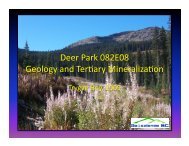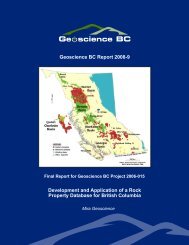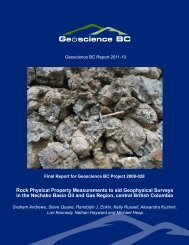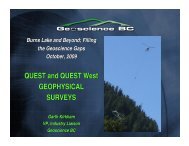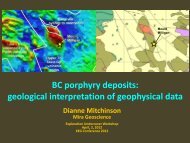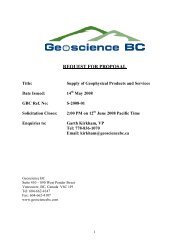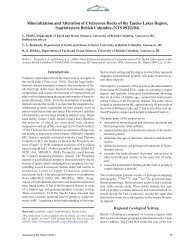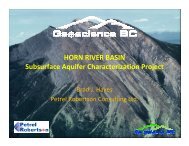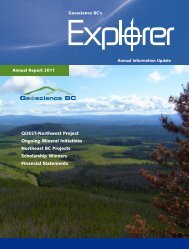Notes Accompanying Original Release of Maps - Geoscience BC
Notes Accompanying Original Release of Maps - Geoscience BC
Notes Accompanying Original Release of Maps - Geoscience BC
- No tags were found...
You also want an ePaper? Increase the reach of your titles
YUMPU automatically turns print PDFs into web optimized ePapers that Google loves.
Metallogenesis <strong>of</strong> the Iskut River Area, Northwestern B.C. --- Regional maps, Lewis<br />
and Pseudoliocerous constrain an Upper Aalenian<br />
age for turbiditic mudstone and siltstone. Together,<br />
these fossil occurrences suggest that sedimentation<br />
spans the Upper Pliensbachian, the Toarcian, and most<br />
<strong>of</strong> the Aalenian stages, although no single section<br />
includes fauna diagnostic <strong>of</strong> all three stages. Isotopic<br />
ages in the Iskut River area are consistent with a<br />
magmatic gap in this time period.<br />
Salmon River Formation: Bimodal volcanic<br />
unit<br />
The upper part <strong>of</strong> the Hazelton Group in the Iskut<br />
River area comprises dacitic to rhyolitic flows and<br />
tuffs, localized interlayered basaltic flows, and<br />
intercalated volcaniclastic intervals. Although these<br />
different rock types can easily be mapped separately<br />
on a property scale, their interfingering nature and<br />
lack <strong>of</strong> continuity dictate that they be grouped into a<br />
single unit for regional mapping purposes. This part<br />
<strong>of</strong> the Hazelton Group has attracted the most attention<br />
<strong>of</strong> geologists due to its association with mineralization<br />
at Eskay Creek, but at the same time its distribution,<br />
internal stratigraphy, and age are poorly understood.<br />
Previous workers have mapped felsic volcanic<br />
components as the Mount Dilworth formation, and<br />
mafic volcanic components as a distinct facies <strong>of</strong> the<br />
Salmon River Formation. These assignments become<br />
problematic with latest mapping constraints which<br />
demonstrate that locally more than one felsic horizon<br />
exists, and that mafic volcanic rocks occur both above<br />
and below these felsic intervals.<br />
The accompanying maps assign all Hazelton<br />
Group rocks above the Treaty Ridge Member to the<br />
Salmon River Formation, which is subdivided into the<br />
Bruce Glacier, Troy Ridge, Eskay Rhyolite, and John<br />
Peaks members.<br />
Bruce Glacier Member:<br />
The Bruce Glacier Member <strong>of</strong> the Salmon River<br />
Formation comprises widely distributed dacite to<br />
rhyolite flows, tuffs, and epiclastic rocks. These rocks<br />
vary from as little as a few tens <strong>of</strong> metres to over<br />
400 metres in thickness, with thickest accumulations<br />
on the west limb <strong>of</strong> the McTagg Anticlinorium<br />
between the Bruce Glacier and the Iskut River valley.<br />
Lith<strong>of</strong>acies within the member are highly variable both<br />
regionally and vertically in a given section. Deposits<br />
proximal to extrusive centres include banded flows,<br />
massive domes with carapace breccias, autoclastic<br />
megabreccias, and block tuffs. Extrusive centres have<br />
been identified at several locations in the Iskut River<br />
area, including Brucejack Lake, Julian Lake (near the<br />
headwaters <strong>of</strong> Snippaker Creek) and Bruce Glacier.<br />
These felsic extrusive centres are characterized by<br />
thick, domal porphyritic centres, grading outward to<br />
flow breccias and talus piles. Slightly to densely<br />
welded lapilli to ash tuffs characterize more distal<br />
equivalents. Reworked tuffs locally form thick<br />
epiclastic accumulations and may fill in paleobasins<br />
adjacent to extrusive centres.<br />
Troy Ridge Member:<br />
Sedimentary and tuffaceous sedimentary rocks<br />
<strong>of</strong> the Salmon River Formation are assigned to the<br />
Troy Ridge Member. This member includes the<br />
distinctive black and white striped strata known as<br />
the “pyjama beds” at Salmon River and are present<br />
to a lesser extent in northern parts <strong>of</strong> the area and<br />
the mineralized contact zone mudstone at Eskay<br />
Creek. Contact relations with other Salmon River<br />
Formation members are variable: for example, at<br />
Eskay Creek the member lies above the Eskay<br />
Rhyolite and Bruce Glacier Members, but below the<br />
John Peaks Member. At Julian Lakes the member is<br />
interstratified with rocks assigned to both the John<br />
Peaks and Bruce Glacier members. These types <strong>of</strong><br />
stratigraphic relationships suggests that the Troy Ridge<br />
Member represents sediments accumulated during<br />
breaks in local volcanic activity.<br />
John Peaks Member:<br />
Mafic components <strong>of</strong> the Salmon River<br />
Formation, assigned here to the John Peaks Member,<br />
are localized in their distribution and are missing from<br />
much <strong>of</strong> the Iskut River area. Generally they occur<br />
above the felsic members (Bruce Glacier and Eskay<br />
Rhyolite), but at Treaty Creek thick sections <strong>of</strong> mafic<br />
flows and breccias lie below welded tuffs <strong>of</strong> the Bruce<br />
Glacier Member. Mafic sections are thickest at Mount<br />
Shirley and near the mouth <strong>of</strong> Sulphurets Creek, and<br />
form intermediate thicknesses at Eskay Creek and<br />
Johnny Mountain. Textures present include massive<br />
flows, pillowed flows, broken pillow breccias, and<br />
volcanic breccias. Plagioclase phenocrysts up to 2 cm<br />
long are characteristic <strong>of</strong> the pillowed sequence south<br />
<strong>of</strong> John Peaks. At Treaty Glacier the mafic<br />
component grades upward from pillowed and massive<br />
flows into broken pillow breccia, and finally,<br />
hyaloclastite matrix supporting abundant irregular<br />
globular volcanic fragments.<br />
Eskay Rhyolite Member:<br />
81





